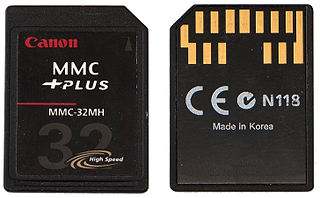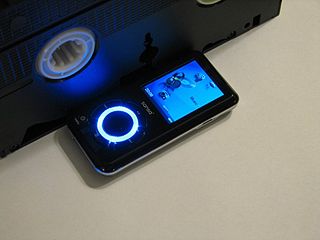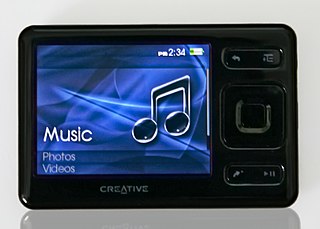Related Research Articles

The Memory Stick is a removable flash memory card format, originally launched by Sony in late 1998. In addition to the original Memory Stick, this family includes the Memory Stick PRO, a revision that allows greater maximum storage capacity and faster file transfer speeds; Memory Stick Duo, a small-form-factor version of the Memory Stick ; the even smaller Memory Stick Micro (M2), and the Memory Stick PRO-HG, a high speed variant of the PRO to be used in high-definition video and still cameras.

CompactFlash (CF) is a flash memory mass storage device used mainly in portable electronic devices. The format was specified and the devices were first manufactured by SanDisk in 1994.

Secure Digital, officially abbreviated as SD, is a proprietary non-volatile memory card format developed by the SD Association (SDA) for use in portable devices.

The MultiMediaCard, officially abbreviated as MMC, is a memory card standard used for solid-state storage. Unveiled in 1997 by SanDisk and Siemens AG, MMC is based on a surface-contact low pin-count serial interface using a single memory stack substrate assembly, and is therefore much smaller than earlier systems based on high pin-count parallel interfaces using traditional surface-mount assembly such as CompactFlash. Both products were initially introduced using SanDisk NOR-based flash technology. MMC is about the size of a postage stamp: 24 mm × 32 mm × 1.4 mm. MMC originally used a 1-bit serial interface, but newer versions of the specification allow transfers of 4 or 8 bits at a time. MMC can be used in many devices that can use Secure Digital (SD) cards.

SmartMedia is a flash memory card standard owned by Toshiba, with capacities ranging from 2 MB to 128 MB. The format mostly saw application in the early 2000s in digital cameras and audio production. SmartMedia memory cards are no longer manufactured.

The xD-Picture Card is an obsolete form of flash memory card, used in digital cameras made by Olympus and Fujifilm during the 2000s. The xD in the xD-Picture Card stands for eXtreme Digital.

ZEN is a series of discontinued portable media players designed and manufactured by Creative Technology Limited. The players evolved from the NOMAD brand through the NOMAD Jukebox series of music players, with the first separate "ZEN" branded models released in 2004. The last Creative Zen player, X-Fi3, was released at the end of 2011.

P2 is a professional digital recording solid-state memory storage media format introduced by Panasonic in 2004, and especially tailored to electronic news-gathering (ENG) applications. It features tapeless (non-linear) recording of DV, DVCPRO, DVCPRO25, DVCPRO50, DVCPRO-HD, or AVC-Intra streams on a solid-state flash memory. The P2 card is essentially a RAID of Secure Digital (SD) memory cards with an LSI controller tightly packaged in a die-cast PC Card enclosure, so data transfer rate increases as memory capacity increases. The system includes cameras, decks as drop-in replacements for videocassette recorders (VCR), and a special 5.25-inch computer drive for random-access integration with non-linear editing systems (NLE). The cards can also be used directly where a PC card (PCMCIA) slot is available, as in most older notebook computers, as a normal hard disk drive, although a custom software driver must first be loaded.
This table provides summary of comparison of various flash memory cards, as of 2017.

The Sansa e200 series is a portable media player developed by SanDisk, and released on January 5, 2006. The device is available in four capacities of Flash memory: 2 GB (e250), 4 GB (e260), 6 GB (e270), and 8 GB (e280). All players have a 1.8-inch, TFT LCD display with a resolution of 176 by 220 pixels. Certain files, if not in a format accepted by the player's original firmware, must first be converted with the Sansa Media Converter Windows software. This will convert images to bitmap format (.bmp) and videos to MJPEG, for v1 models. On v2 players it will convert videos to DivX and simply resize images. It is not possible to simply copy videos to the device, even if they seem to be in the correct format; trying to access them displays an error message.
Samsung SCH-U520 is a phone released on December 7, 2006 by the former U.S. wireless operator Alltel Wireless. The phone was the first phone to support Alltel's Axcess Mobile Guide service. The service allows customers to hear voice turn-by-turn navigation, view maps, find locations, plan trips and more.

The SanDisk Sansa is a line of 2- to 32-gigabyte flash memory-based portable media players produced by SanDisk since 2005.

The SD Association (SDA) is an American nonprofit organization that sets memory card standards intended to simplify the use and optimize the performance of consumer electronics that people use in every country. SanDisk, Panasonic (Matsushita) and Toshiba formed the SD Association in January 2000. Today, the SDA has approximately 1,000 member companies involved in the design and development of SD standards. Thousands of device models and hundreds of products across dozens of product categories integrate the small, removable memory cards.

The ZEN is a portable media player designed and manufactured by Creative Technology. This flash memory-based player is the de facto successor of the ZEN Vision:M and was announced on August 29, 2007, to be available in capacities of 2, 4, 8, and 16 GB, as of September 14. A 32 GB model was announced on December 4, 2007, setting a record for storage capacity among flash players.
Gruvi was a short-lived memory card format compatible with microSD developed by Sandisk in 2006. It used the company's TrustedFlash card technology, which functioned like the conventional SD card but it could be extended to on-demand content. The cards were intended for the distribution of music and videos and had a variety of special Digital rights management features including the ability to pre-load content that could be 'unlocked' at a later date. The announced objective was the replacement of CDs, which was highlighted by the involvement of music publisher EMI when the product was launched. The little cards featured a picture of the artist whose music was pre-loaded. They were compatible with mobile phones, t, and laptop computers. Only a handful of Gruvi cards were ever released, one of them was the album A Bigger Bang by the Rolling Stones.
MOD and TOD are recording formats for use in digital tapeless camcorders. The formats are comparable to XDCAM EX, HDV and AVCHD.

The Sansa Fuze is a portable media player developed by SanDisk and released on March 8, 2008. The Fuze is available in three different Flash memory capacities: 2 GB, 4 GB, and 8 GB and comes in six different colors: black, blue, pink, red, silver, and white. Storage is expandable via a microSDHC slot with capacity up to 32 GB, and unofficially to 64 GB or more via FAT32 formatted SDXC cards. All models have a 1.9 inch TFT LCD display with a resolution of 220 by 176 pixels and a built-in monaural microphone and FM tuner; recordings of the latter two are saved as PCM WAV files.
slotRadio was a proprietary format developed by SanDisk that delivered music on a microSD memory card. Up to 1,000 songs were preloaded on microSD cards which were DRM protected. Users had no direct access to the music to copy songs, organize playlists, or download the songs from the card. Songs could only be played using a SanDisk Sansa music player that supported the SlotRadio formatted microSD cards.

The Sansa c200 series is a line of portable media players developed by SanDisk. The line consists of two models: the c240, 1 GB, the c250, 2 GB. Both models feature a micro SD card slot, a 1.4 inch LCD display, a built-in microphone, and an FM radio. c200 series players are available in four colors: black, red, pink, and blue.

The Sansa Fuze+ is a portable media player manufactured by SanDisk as part of their Sansa line of MP3 players. The Fuze+ was released on September 1st 2010, and is the direct successor to the Sansa Fuze. The Sansa Fuze+ is available in five colors: Black, Blue, Purple, Red, and White. Internal storage capacities of the player vary by color.
References
- 1 2 3 Maney, Kevin (2008-09-22). "SanDisk's New SlotMusic: But Why?". Portfolio.com. Retrieved 2008-12-02.
- 1 2 3 4 5 6 ""slotMusic": High Quality, DRM-Free MP3 Music on microSD Cards" (Press release). SanDisk. 2008-09-22. Retrieved 2008-12-02.
- ↑ "slotMusic Cards Now Shipping: More Than 40 Top Artists Available from Nearly Every Genre of Music" (Press release). SanDisk. 2008-10-15. Retrieved 2008-12-16.